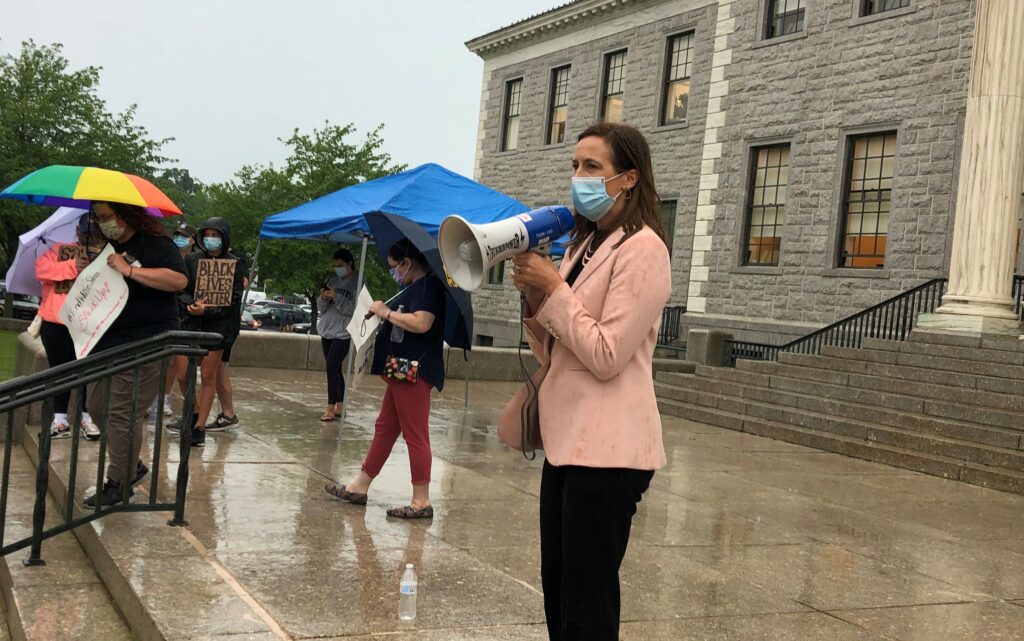Sherrill Demands Answers From NCAA on Women’s Basketball Tournament Disparities

Representative Mikie Sherrill (D-11), along with thirty-six colleagues, wrote to Mark Emmert, President of the National Collegiate Athletic Association (NCAA), to demand answers and accountability for the recently reported disparate treatment of women’s and men’s teams in the Division One championship tournaments.
The letter enumerates the reported disparities including stark differences in the conditioning facilities, food, publicity and marketing, and even the use of less accurate COVID tests. The letter calls on the NCAA to live up to the “spirit of Title IX” and ensure that athletes are not being discriminated against. While the NCAA is not directly subject to Title IX, it controls the athletes and federally funded schools that are subject to Title IX. These education institutions, supported by federal financial assistance, cede controlling authority to the NCAA of its athletes and athletic program in order to participate in NCAA championship tournaments. The letter also requests a direct response to their inquiries, including how the NCAA will ensure equitable treatment in the future.
“As you know, these athletes train all year and demonstrate unmatched levels of commitment to their sport and their universities. Yet, the players on the women’s and men’s teams have not been treated equally by the NCAA,” the lawmakers wrote. “Such actions are deeply concerning and reflect NCAA’s lack of commitment to the spirit of Title IX to ensure a level playing field for women in athletics that are subsidized with federal financial assistance. Despite having corrected at least some of these infractions, the NCAA’s clear disregard for women cannot be tolerated.”
Find the full text of the letter here:
Dear Mr. Emmert:
We are writing to share our deep concerns regarding the unequal treatment of the women’s and men’s basketball teams during the National Collegiate Athletic Association’s (NCAA) Division One championship tournament and ask that you fully address the disparities and seek to review all other championship competitions to ensure that they adhere to the gender equity principles of Title IX in affording women athletes fair and equal treatment.
Each year, the NCAA’s Division One tournament for women’s and men’s basketball—also known as March Madness—brings together top college athletes from across the country to compete. It’s a coveted tournament and is long awaited by fans and players alike. As you know, these athletes train all year and demonstrate unmatched levels of commitment to their sport and their universities. Yet, the players on the women’s and men’s teams have not been treated equally by the NCAA.
The Title IX of the Educational Amendments Act of 1972 prohibits discrimination on the basis of sex in education programs or activities, including athletic programs, receiving federal financial assistance. Specifically, institutions must provide equal athletic opportunities as well as equivalent benefits and treatment for members of both sexes including, but not limited to: equipment and supplies; game and practice times; locker rooms, practice and competitive facilities; medical and training facilities and services; housing and dining facilities and services; and publicity.
While the NCAA is not directly subject to Title IX, it nonetheless controls the athletes and federally funded schools that are subject to Title IX. These education institutions, supported by federal financial assistance, cede controlling authority to NCAA of its athletes and athletic program in order to participate in NCAA championship tournaments. The gross disparities reported violate the spirit of Title IX and undermine the Act’s gender equity principles to ensure that women athletes competing at the highest level are treated without regard to discrimination.
Reports of stark differences in treatment include:
- Conditioning Facilities: Players at the men’s tournament received a huge, fully stocked workout complex housed in a hotel ballroom while the women received a small space with only one rack of hand weights. Despite each tournament having at least 64 teams, the men were given workout equipment including dumbbells, barbells, stationary bikes, treadmills, and squat machines. In contrast, the women were given just a single rack of dumbbells, none heavier than 30 pounds.[1]
- Food/Nutrition: Players at the men’s tournament were provided an expansive buffet of food options including, but not limited to: chopped salad, grilled asparagus, potatoes au gratin, lobster macaroni and cheese, petite filet, bread pudding, cheese cake, and carrot cake.[2] In comparison, players at the women’s tournament were handed plastic containers filled with mashed potatoes, a small mix of vegetables, and what players described as “some kind of meat”.[3]
- COVID Tests: Players at the men’s tournament receive polymerase chain reaction (PCR) tests, which are considered the gold standard of COVID-19 testing. PCR tests are highly sensitive and have high rates of accuracy for detecting the virus.[4] Alternatively, players at the women’s tournament receive a rapid antigen test, these tests are cheaper and less sensitive — meaning they’re more likely to yield false negatives.
- Publicity: The men’s tournament uses the trademarked “March Madness” phrase, a powerful brand that’s ubiquitous among courts, arenas, and broadcasts. The branding has helped the NCAA turn the men’s tournament into a billion-dollar empire. At the same time, they’ve refused to use it for the women’s tournament, even though its trademark registration for the phrase allows its use for both tournaments.[5] Instead, the women’s courts either have no tournament logo or simply say “NCAA Women’s Basketball”.[6] Refusing to use the branding for the women’s tournament is intentionally withholding a valuable asset.
Such actions are deeply concerning and reflect NCAA’s lack of commitment to the spirit of Title IX to ensure a level playing field for women in athletics that are subsidized with federal financial assistance. Despite having corrected at least some of these infractions, the NCAA’s clear disregard for women cannot be tolerated.
Accordingly, we ask that you fully address the disparities outlined above and provide responses to the following:
- Seek to review all other championship competitions to ensure that they adhere to the gender equity principles of Title IX in affording women athletes fair and equal treatment.
- Provide a detailed timeline of the unequal treatment of the women’s and men’s basketball teams during the championship tournament, including when it began, its discovery, any investigation of its scope, and notification to the NCAA’s senior executives.
- Please describe the NCAA’s efforts to identify the scope of the disparities.
- Are there other instances of unequal treatment that have not been stated above?
- What steps has the NCAA taken to identify and limit unequal treatment in the current tournament?
- Does the NCAA have procedures in place to receive and act on reports of unequal treatment?
- If so, please describe these procedures, when they were implemented, and how frequently the NCAA acts to remediate unequal treatment.
- When the NCAA was first notified of unequal treatment, what immediate steps did it take to address these issues?
- What processes does the NCAA have in place to ensure all other championship competitions adhere to the gender equity principles of Title IX.
- What specific steps is the NCAA taking to ensure that such unequal treatment is not repeated in future tournaments?
- Please describe the resources that the NCAA dedicates to identifying, investigating, and addressing the unequal treatment of its men’s and women’s sports teams.
- Does the NCAA employ a Chief Diversity Officer? If so, to whom does this person report?
We request that the NCAA respond to this request no later than April 2, 2021. Thank you for your prompt attention to this important issue.
Sincerely,
Mikie Sherrill, Member of Congress
Lisa Blunt Rochester, Member of Congress
Ritchie Torres, Member of Congress
Albio Sires, Member of Congress
Doris Matsui, Member of Congress
Katherine Clark, Member of Congress
Jackie Speier, Member of Congress
André Carson, Member of Congress
Jahana Hayes, Member of Congress
Jim Cooper, Member of Congress
Thomas R. Suozzi, Member of Congress
Pramila Jayapal, Member of Congress
Jerrold Nadler, Member of Congress
Grace F. Napolitano, Member of Congress
John B. Larson, Member of Congress
Al Lawson, Member of Congress
Deborah K. Ross, Member of Congress
Sara Jacobs, Member of Congress
Grace Meng, Member of Congress
Raúl Grijalva, Member of Congress
Josh Gottheimer, Member of Congress
Lois Frankel, Member of Congress
Carolyn B. Maloney, Member of Congress
Colin Allred, Member of Congress
Kathy Castor, Member of Congress
Andy Levin, Member of Congress
Bill Foster, Member of Congress
Alcee L. Hastings, Member of Congress
Alma S. Adams, Member of Congress
Lori Trahan, Member of Congress
Nydia M. Velázquez, Member of Congress
Brenda L. Lawrence, Member of Congress
Suzanne Bonamici, Member of Congress
Debbie Wasserman Schultz, Member of Congress
Haley Stevens, Member of Congress
Chellie Pingree, Member of Congress
Jan Schakowsky, Member of Congress











Leave a Reply